1. Parkins MD, Gregson DB, Pitout JD, Ross T, Laupland KB. Population-based study of the epidemiology and the risk factors for
Pseudomonas aeruginosa bloodstream infection. Infection. 2010; 38(1):25–32. PMID:
20012908.
2. Callejas-Díaz A, Fernández-Pérez C, Ramos-Martínez A, Múñez-Rubio E, Sánchez-Romero I, Vargas Núñez JA. Impact of
Pseudomonas aeruginosa bacteraemia in a tertiary hospital: mortality and prognostic factors. Med Clin (Barc). 2019; 152(3):83–89. PMID:
29885868.
3. Kang CI, Kim SH, Kim HB, Park SW, Choe YJ, Oh MD, et al.
Pseudomonas aeruginosa bacteremia: risk factors for mortality and influence of delayed receipt of effective antimicrobial therapy on clinical outcome. Clin Infect Dis. 2003; 37(6):745–751. PMID:
12955633.
4. Suárez C, Peña C, Tubau F, Gavaldà L, Manzur A, Dominguez MA, et al. Clinical impact of imipenem-resistant
Pseudomonas aeruginosa bloodstream infections. J Infect. 2009; 58(4):285–290. PMID:
19297028.
5. Buehrle DJ, Shields RK, Clarke LG, Potoski BA, Clancy CJ, Nguyen MH. Carbapenem-resistant
Pseudomonas aeruginosa bacteremia: risk factors for mortality and microbiologic treatment failure. Antimicrob Agents Chemother. 2016; 61(1):e01243-16. PMID:
27821456.

6. Kadri SS, Adjemian J, Lai YL, Spaulding AB, Ricotta E, Prevots DR, et al. Difficult-to-treat resistance in gram-negative bacteremia at 173 US hospitals: retrospective cohort analysis of prevalence, predictors, and outcome of resistance to all first-line agents. Clin Infect Dis. 2018; 67(12):1803–1814. PMID:
30052813.

7. Merchant S, Proudfoot EM, Quadri HN, McElroy HJ, Wright WR, Gupta A, et al. Risk factors for
Pseudomonas aeruginosa infections in Asia-Pacific and consequences of inappropriate initial antimicrobial therapy: a systematic literature review and meta-analysis. J Glob Antimicrob Resist. 2018; 14:33–44. PMID:
29454906.
10. Horcajada JP, Montero M, Oliver A, Sorlí L, Luque S, Gómez-Zorrilla S, et al. Epidemiology and treatment of multidrug-resistant and extensively drug-resistant
Pseudomonas aeruginosa Infections. Clin Microbiol Rev. 2019; 32(4):e00031-19. PMID:
31462403.

11. Tamma PD, Aitken SL, Bonomo RA, Mathers AJ, van Duin D, Clancy CJ. Infectious Diseases Society of America guidance on the treatment of extended-spectrum β-lactamase producing
Enterobacterales (ESBL-E), carbapenem-resistant
Enterobacterales (CRE), and
Pseudomonas aeruginosa with difficult-to-treat resistance (DTR-
P. aeruginosa). Clin Infect Dis. 2021; 72(7):e169–e183. PMID:
33106864.
12. Korea Centers for Disease Control and Prevention (KCDC). Korean Antimicrobial Resistance Monitoring System: KARMS 2016 Annual Report. Cheongju, Korea: KCDC;2018.
13. Liu C, Yoon EJ, Kim D, Shin JH, Shin JH, Shin KS, et al. Antimicrobial resistance in South Korea: a report from the Korean Global Antimicrobial Resistance Surveillance System (Kor-GLASS) for 2017. J Infect Chemother. 2019; 25(11):845–859. PMID:
31311694.

14. Raman G, Avendano EE, Chan J, Merchant S, Puzniak L. Risk factors for hospitalized patients with resistant or multidrug-resistant
Pseudomonas aeruginosa infections: a systematic review and meta-analysis. Antimicrob Resist Infect Control. 2018; 7:79. PMID:
29997889.

15. Aloush V, Navon-Venezia S, Seigman-Igra Y, Cabili S, Carmeli Y. Multidrug-resistant
Pseudomonas aeruginosa: risk factors and clinical impact. Antimicrob Agents Chemother. 2006; 50(1):43–48. PMID:
16377665.
16. Palavutitotai N, Jitmuang A, Tongsai S, Kiratisin P, Angkasekwinai N. Epidemiology and risk factors of extensively drug-resistant
Pseudomonas aeruginosa infections. PLoS One. 2018; 13(2):e0193431. PMID:
29470531.
17. Samonis G, Vardakas KZ, Kofteridis DP, Dimopoulou D, Andrianaki AM, Chatzinikolaou I, et al. Characteristics, risk factors and outcomes of adult cancer patients with extensively drug-resistant
Pseudomonas aeruginosa infections. Infection. 2014; 42(4):721–728. PMID:
24912861.
18. Lee CH, Su TY, Ye JJ, Hsu PC, Kuo AJ, Chia JH, et al. Risk factors and clinical significance of bacteremia caused by
Pseudomonas aeruginosa resistant only to carbapenems. J Microbiol Immunol Infect. 2017; 50(5):677–683. PMID:
26188977.
19. Joo EJ, Kang CI, Ha YE, Kang SJ, Park SY, Chung DR, et al. Risk factors for mortality in patients with
Pseudomonas aeruginosa bacteremia: clinical impact of antimicrobial resistance on outcome. Microb Drug Resist. 2011; 17(2):305–312. PMID:
21381966.
20. Clinical and Laboratory Standards Institute (CLSI). Performance Standards for Antimicrobial Susceptibility Testing. 29th ed. Wayne, PA, USA: CLSI;2019.
21. Yo CH, Hsein YC, Wu YL, Hsu WT, Ma MH, Tsai CH, et al. Clinical predictors and outcome impact of community-onset polymicrobial bloodstream infection. Int J Antimicrob Agents. 2019; 54(6):716–722. PMID:
31560960.

22. Haque M, Sartelli M, McKimm J, Abu Bakar M. Health care-associated infections - an overview. Infect Drug Resist. 2018; 11:2321–2333. PMID:
30532565.
23. Revelas A. Healthcare - associated infections: a public health problem. Niger Med J. 2012; 53(2):59–64. PMID:
23271847.

25. Singer M, Deutschman CS, Seymour CW, Shankar-Hari M, Annane D, Bauer M, et al. The third international consensus definitions for sepsis and septic shock (Sepsis-3). JAMA. 2016; 315(8):801–810. PMID:
26903338.

26. Magiorakos AP, Srinivasan A, Carey RB, Carmeli Y, Falagas ME, Giske CG, et al. Multidrug-resistant, extensively drug-resistant and pandrug-resistant bacteria: an international expert proposal for interim standard definitions for acquired resistance. Clin Microbiol Infect. 2012; 18(3):268–281. PMID:
21793988.

27. Aryee A, Rockenschaub P, Gill MJ, Hayward A, Shallcross L. The relationship between clinical outcomes and empirical antibiotic therapy in patients with community-onset gram-negative bloodstream infections: a cohort study from a large teaching hospital. Epidemiol Infect. 2020; 148:e225. PMID:
32912362.

28. Kadri SS, Lai YL, Warner S, Strich JR, Babiker A, Ricotta EE, et al. Inappropriate empirical antibiotic therapy for bloodstream infections based on discordant in-vitro susceptibilities: a retrospective cohort analysis of prevalence, predictors, and mortality risk in US hospitals. Lancet Infect Dis. 2021; 21(2):241–251. PMID:
32916100.

29. Korean Disease Control and Prevention Agency (KDCA). National Antimicrobial Resistance Surveillance in Korea 2019 Annual Report. Cheongju, Korea: KDCA;2020.
31. Tuon FF, Gortz LW, Rocha JL. Risk factors for pan-resistant
Pseudomonas aeruginosa bacteremia and the adequacy of antibiotic therapy. Braz J Infect Dis. 2012; 16(4):351–356. PMID:
22846123.
32. Nathwani D, Raman G, Sulham K, Gavaghan M, Menon V. Clinical and economic consequences of hospital-acquired resistant and multidrug-resistant
Pseudomonas aeruginosa infections: a systematic review and meta-analysis. Antimicrob Resist Infect Control. 2014; 3(1):32. PMID:
25371812.

33. Bassetti M, Vena A, Croxatto A, Righi E, Guery B. How to manage
Pseudomonas aeruginosa infections. Drugs Context. 2018; 7:212527. PMID:
29872449.
34. Montero MM, López Montesinos I, Knobel H, Molas E, Sorlí L, Siverio-Parés A, et al. Risk factors for mortality among patients with Pseudomonas aeruginosa bloodstream infections: What is the influence of XDR phenotype on outcomes? J Clin Med. 2020; 9(2):514.
35. Kim YJ, Jun YH, Kim YR, Park KG, Park YJ, Kang JY, et al. Risk factors for mortality in patients with
Pseudomonas aeruginosa bacteremia; retrospective study of impact of combination antimicrobial therapy. BMC Infect Dis. 2014; 14:161. PMID:
24655422.

36. Peña C, Cabot G, Gómez-Zorrilla S, Zamorano L, Ocampo-Sosa A, Murillas J, et al. Influence of virulence genotype and resistance profile in the mortality of
Pseudomonas aeruginosa bloodstream infections. Clin Infect Dis. 2015; 60(4):539–548. PMID:
25378459.
37. Jeong SJ, Yoon SS, Bae IK, Jeong SH, Kim JM, Lee K. Risk factors for mortality in patients with bloodstream infections caused by carbapenem-resistant
Pseudomonas aeruginosa: clinical impact of bacterial virulence and strains on outcome. Diagn Microbiol Infect Dis. 2014; 80(2):130–135. PMID:
25112900.
38. Matuschek E, Åhman J, Webster C, Kahlmeter G. Antimicrobial susceptibility testing of colistin - evaluation of seven commercial MIC products against standard broth microdilution for
Escherichia coli,
Klebsiella pneumoniae,
Pseudomonas aeruginosa, and
Acinetobacter spp. Clin Microbiol Infect. 2018; 24(8):865–870. PMID:
29221995.
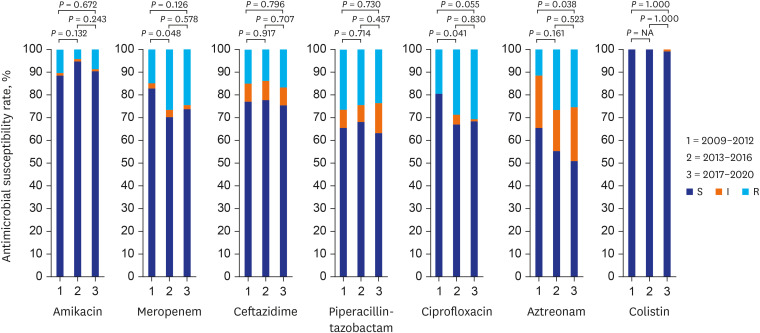

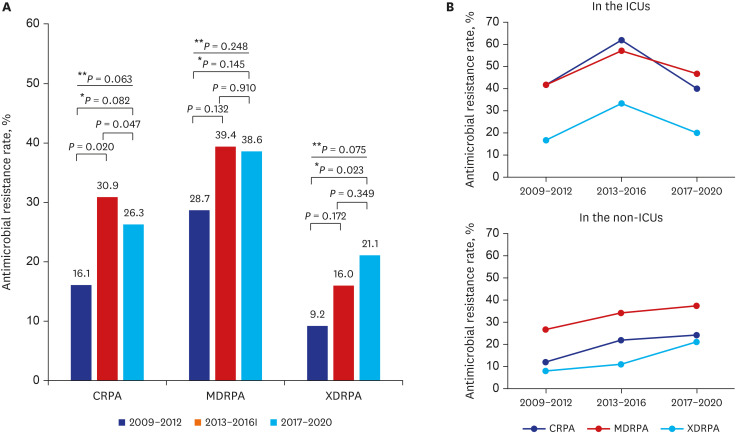
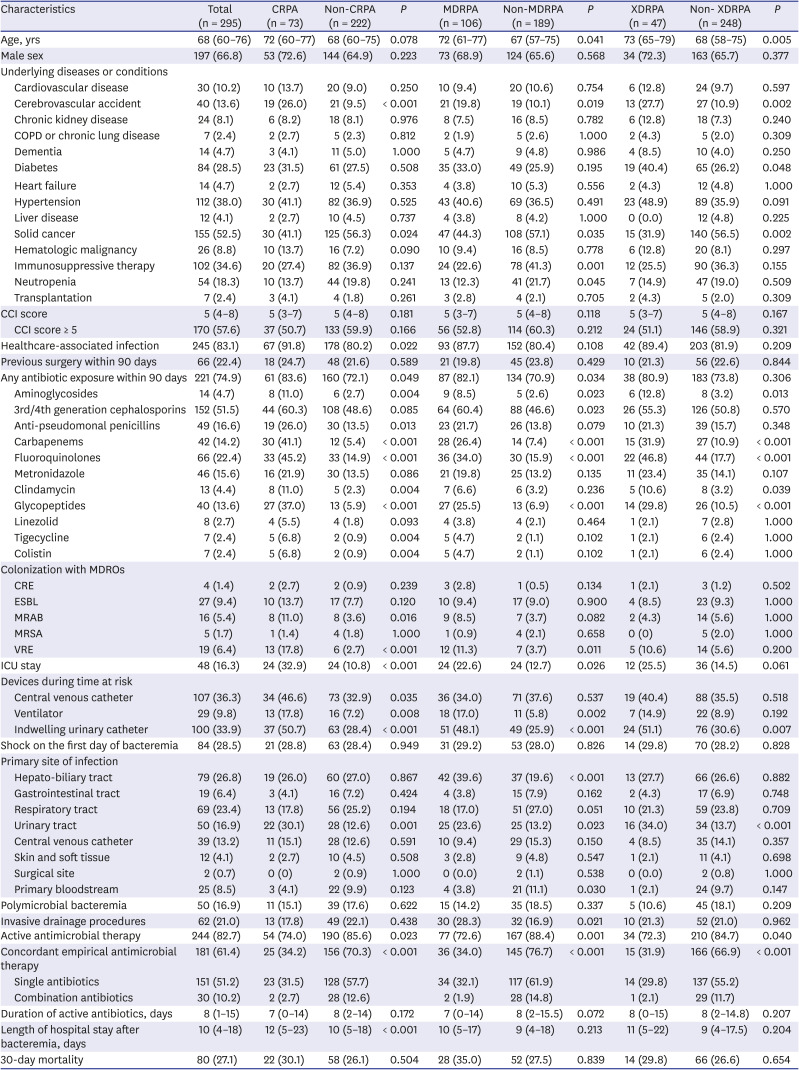
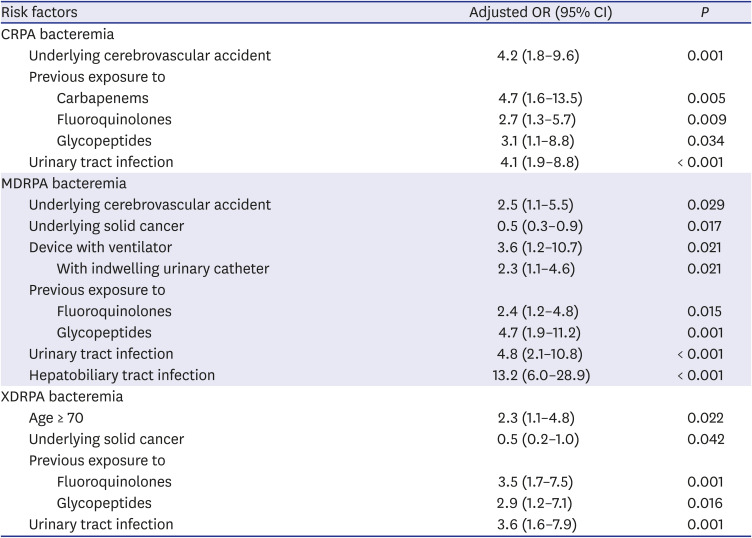
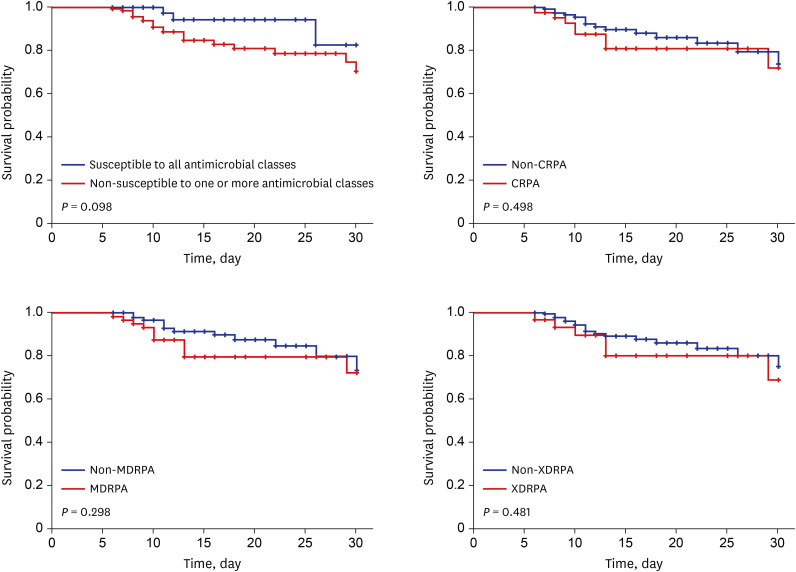
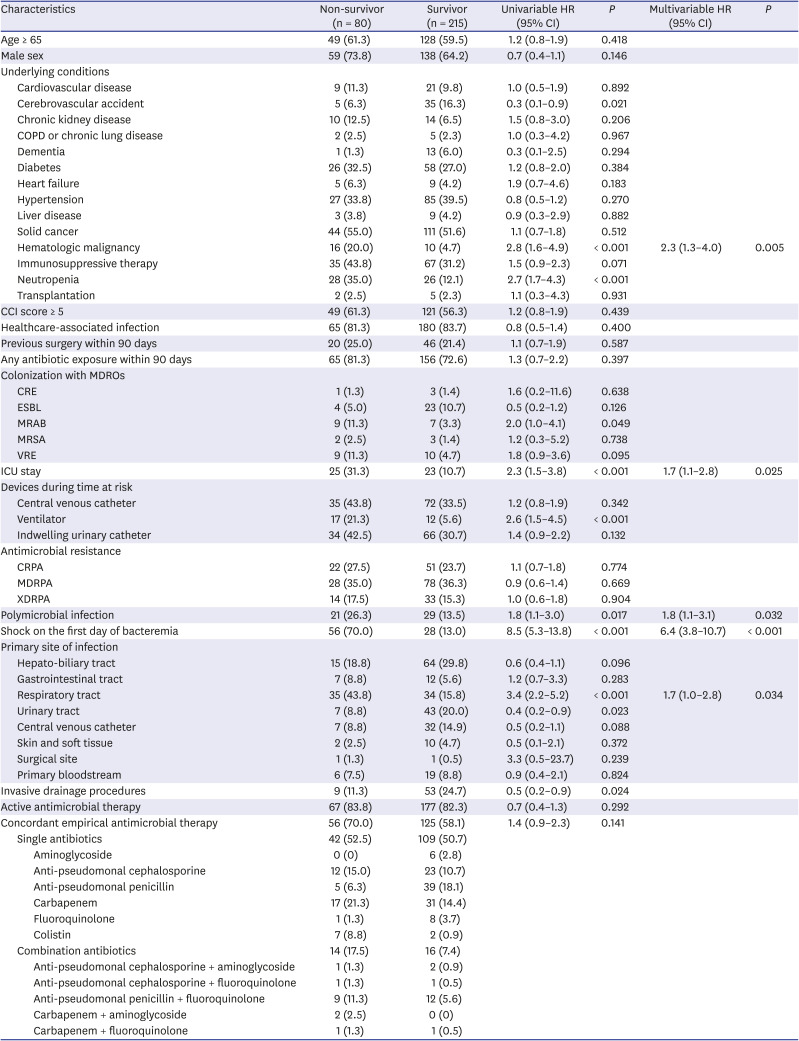




 PDF
PDF Citation
Citation Print
Print



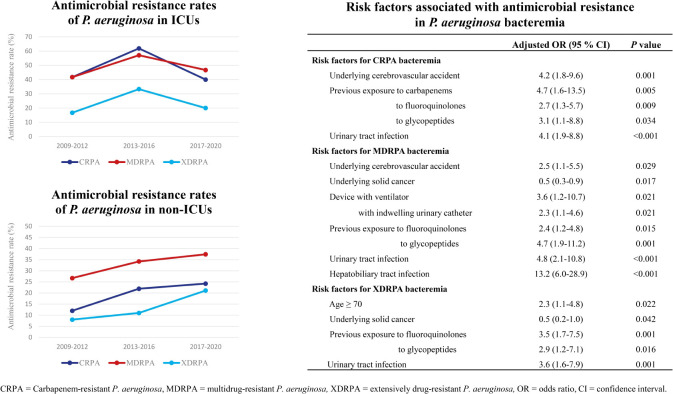

 XML Download
XML Download